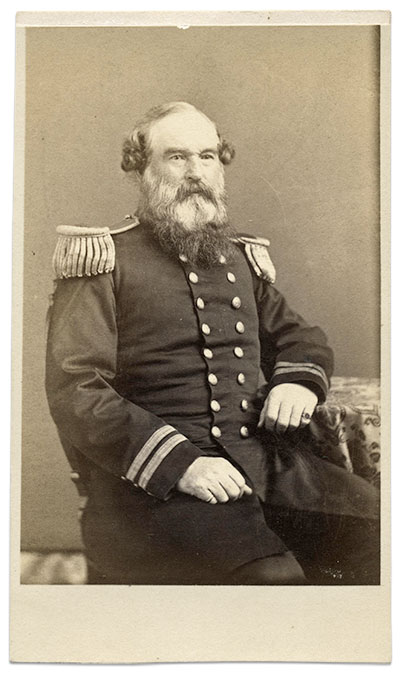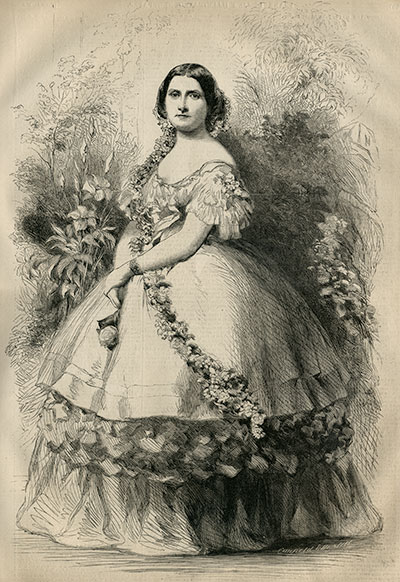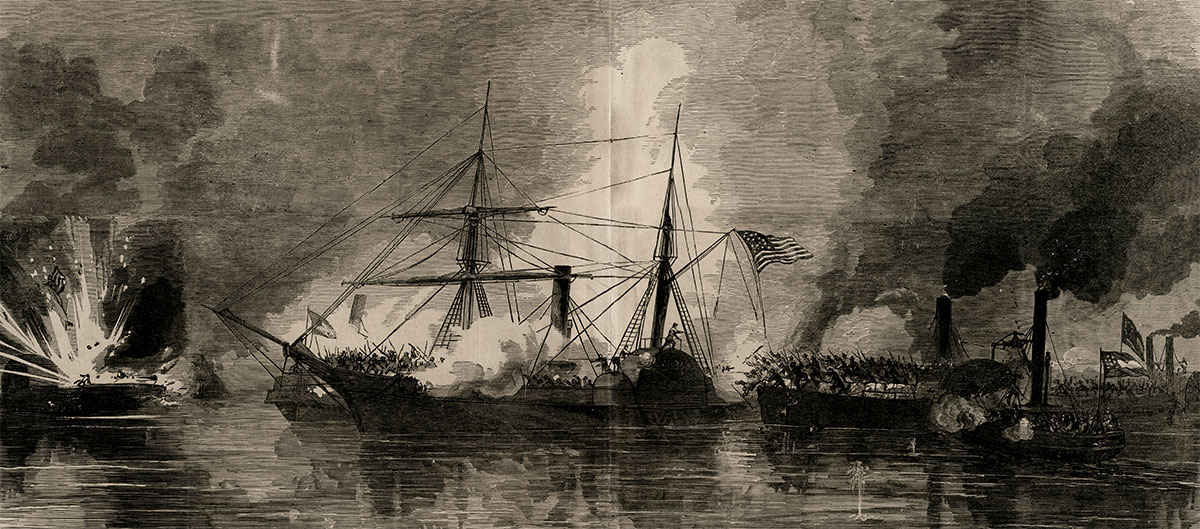By Ronald S. Coddington
A lone steamer rigged with brigantine sails and bristling with armaments sped on a collision course towards Charleston harbor during the evening of April 11, 1861.
The sleek, state of the art side-wheeler, Harriet Lane, sliced through the coastal waters with all the grace of her namesake, the comely young lady who had until very recently served as White House hostess to her bachelor uncle, President James Buchanan.
Meanwhile, alert lookouts positioned in the harbor defenses spotted the vessel on the horizon, and sent two red rockets and a blue flare into the night sky—the signal that an enemy ship approached.
A war was about to begin.
The Harriet Lane was one of the best-known American ships on active duty. Her able commander, the popular John Faunce, had been associated with the Lane from her construction in 1857, and took charge as her original captain the following year. High-profile adventures came quickly. The crew participated in an expeditionary force sent to Paraguay to seek redress for the firing on a U.S. warship that resulted in the death of a sailor. The ship also prowled along the Atlantic coast in search of illegal slave-traders, nabbing several before they attempted the cross to Africa. In 1860, the Lane transported the teen-aged Prince of Wales from Washington to New York on a memorable trip, after which the future King of England presented Faunce with a gold chronometer watch and chain as a token of thanks.

“He loves as his life,” is how one newspaper reporter described Faunce’s feelings for the beautiful Harriet Lane.
As the bitterly divided United States descended to the brink of war after South Carolina seceded from the Union on Dec. 20, 1860, the Buchanan administration pondered its options. Speculation ran rampant throughout the capital. Faunce and the Lane were at the center of one rumor: The captain and his ship had received orders to sail for Charleston with Gen. Winfield Scott, the aging hero of the War of 1812 and Mexican War, along with 200 regulars, to teach the rebels a lesson they would not forget. The New York Commercial Advertiser laid the rumor to rest in its January 2, 1861, edition. “Capt. John Faunce, of the Harriet Lane, states that all the rumors regarding him and the craft he commands are mere fabrications.”
Some truth, however, lied behind the rumor. A civilian steamer, Star of the West, had left New York City on a mission to resupply Fort Sumter. But rebel artillery batteries at Charleston forced her to return without having accomplished the mission.
Three months later, navy officials tapped Faunce for a special mission, and sent him off with sealed orders to be opened at sea.
In New York harbor on the morning of April 8, the Lane hauled down its Revenue Marine Service flag (the vessel belonged to the Treasury Department, and it employed Faunce), and replaced it with the Stars and Stripes to indicate her temporary transfer to the navy. Faunce broke the seal on his orders and learned that he would rendezvous with an expeditionary convoy of ships outside Charleston. There, they would deliver supplies and troops to the beleaguered garrison of Fort Sumter.
On the evening of April 11, the Lane arrived outside Charleston harbor. She had outsailed the convoy, and bade her time until the other vessels arrived.
A pair of South Carolina naval steamers, the Clinch and Seabrook, had been trolling the harbor under orders to prevent an expected federal troop landing. Rockets and flares alerted the ships to the arrival of the Lane about 7:30 p.m. The crews instantly prepared for action. Faunce, keenly aware of the mounting tension, made no aggressive moves. The South Carolinians held their position, but did not advance.
Almost eight hours later on April 12, the federal steamer Baltic arrived on the scene at 3 a.m., and communicated its position to the Lane. The Baltic carried Gustavus V. Fox, a navy man appointed by President Abraham Lincoln to command the relief expedition.
Another federal vessel, the sloop-of-war Pawnee, was spotted about 6 a.m. Fox and Faunce boarded her and met with Cdr. Stephen C. Rowan. Fox informed Rowan of the orders to provision the Fort Sumter garrison. Rowan countered that his own orders required him to wait for the warship Powhatan, which had yet to arrive, and added “that he was not going in there to inaugurate civil war.”

Fox and Faunce left Rowan and determined to go on without the Pawnee. Fox boarded the Baltic and steamed ahead, he reported, “Followed by the Harriet Lane, Captain Faunce, who cheerfully accompanied me. As we neared land heavy guns were heard and the smoke and shells from the batteries which had just opened fire upon Sumter were distinctly visible.”
The Civil War had begun.
Faunce and Fox watched as the Charleston batteries pounded Fort Sumter’s brick walls. Faunce and the Lane remained in position while Fox and the Baltic went to inform Capt. Rowan of the situation. Fox was surprised to meet the Pawnee coming in. Rowan apparently had a change of heart. “He hailed me, declaring his intention of standing in to the harbor and sharing the fate of his brethren of the Army,” Fox explained. “I went on board and informed him that I would answer for it that the Government did not expect any such gallant sacrifice.”
The Lane, Baltic and Pawnee remained outside the harbor. None of the other convoy ships arrived that day. The naval trio was joined by a number of civilian merchant vessels on routine business, and they waited with the Union navy.
While the bombardment raged and gun smoke mixed with low-lying banks of mist, a steamer appeared with no ensign flying. At 11:20 a.m., Faunce and the crew of Lane went to battle stations. They signaled the vessel to show her colors and come to. The ship did not respond. Faunce ordered a warning shot fired. Daniel D. Tompkins, the second lieutenant in charge of the bow gun, obeyed his captain’s command. Some historians credit this event as the first naval shot fired of the Civil War. According to a revenue service historian, “A thirty-two pound shot ricocheted across the bows of the strange steamer, a grim and significant warning to heave to and render an account of herself. The American ensign was at once displayed from her main peak.” She was the merchant steamer Nashville, and Faunce allowed her to pass.

The rest of the convoy finally arrived, but too late to relieve the garrison. Its commander, Maj. Robert Anderson, surrendered Fort Sumter on April 13.
With the surrender complete, the Nashville steamed into the harbor and docked. Confederate authorities seized the vessel and converted her into a cruiser.
Faunce and the Lane went on to participate in amphibious operations—among the earliest of the war—along the North Carolina coast against the shore batteries of Hatteras Inlet on Aug. 28, 1861.
Soon afterwards, the Revenue Marine Service formally transferred the Lane to the navy. Faunce, technically employed by the Service, parted with his beloved vessel. Faunce captained several other revenue cutters during the war, and participated in numerous patrol and transport duties. The navy ordered the Lane and her new commander, Jonathan M. Wainwright II, to the West Gulf Squadron. He was killed in action during a surprise Confederate assault against Union-occupied Galveston, Texas, on Jan. 1, 1863. The Lane fell into enemy hands after being raked by volleys of musket fire, and rammed by one of the rebel warships.

The Lane was repaired and became the blockade-runner Lavinia. On April 30, 1864, she made a successful run with a load of cotton to Havana. Spanish officials detained her until the end of the war.
In 1867, Spain turned over the Lane to the United States. The government sent her first captain to bring her home. Faunce found the ship in poor condition, ravaged by the elements, battered by the rigors of the war, and scuttled by an 1865 fire, rumored to have been started by a disgruntled Confederate crewmember who had traveled aboard her from Galveston and never received his pay. “She had been for some time considered worthless and it will cost more than she is worth to make her at all useful,” declared the New York Times.
Faunce brought her back to life and made her seaworthy again. On March 29, the Lane with Faunce and a skeleton crew arrived in New York City. Government officials ultimately decided that the Lane would never be fit for active duty. They sold the vessel to a Boston merchant who renamed her the Elliot Ritchie. The ship ferried cargos of all types until hurricane-force winds in the Caribbean brought her down in May 1884. The crew abandoned the ship at sea. Her death made news across the country, including this headline in the Washington Evening Star: “Good Bye Harriet! The Last of a Once Famous Vessel.”
By this time, Faunce had concluded his post-war career in the revenue service as the first individual to survey the Atlantic and Pacific Coasts and Great Lakes to locate life-saving stations.
On June 5, 1891, the 50th anniversary of his appointment to the revenue service, Faunce was on the lawn of his Jersey City, N.J., home, laying out a croquet set with his son, when a pain in his side suddenly struck him. His son, daughter and other family members rushed to save him, but he was unconscious and died about five minutes later. The cause of death was attributed to his heart. The watch given to him by the Prince of Wales was in his pocket
Faunce was 85 years old. He had outlived two wives and the Harriet Lane.
References: Charleston Mercury, April 15, 1861; Frank H. Pulsifer, “Reminiscences of the Harriet Lane.” Journal of the United States Coast Guard Association (Vol. I, No. 1, January, February, March 1917); Boston Evening Daily Transcript, Oct. 20, 1860; Columbian Register (New Haven, Connecticut), Sept. 7, 1861; New York Commercial Advertiser, Jan. 2, 1861; James D. McCabe Jr., The Grayjackets: How They Lived, Fought and Died, for Dixie; Official Records of the Union and Confederate Navies; Horatio D. Smith, “The Flag of Our Country.” The United Service: A Monthly Review of Military and Naval Affairs (Vol. VI, No. 1, July 1904); Charleston Mercury, April 30, 1864; New York Times, Jan. 26, 1865, and March 30, 1867; Evening Star (Washington, D.C.), May 20, 1884; New York Times, June 7, 1891; New York Herald, June 7, 1891.
Ronald S. Coddington is Editor and Publisher of MI. He is the author of Faces of the Civil War Navies: An Album of Union and Confederate Sailors, a new book recently released by The Johns Hopkins University Press.
SPREAD THE WORD: We encourage you to share this story on social media and elsewhere to educate and raise awareness. If you wish to use any image on this page for another purpose, please request permission.
LEARN MORE about Military Images, America’s only magazine dedicated to showcasing, interpreting and preserving Civil War portrait photography.
VISIT OUR STORE to subscribe, renew a subscription, and more.

